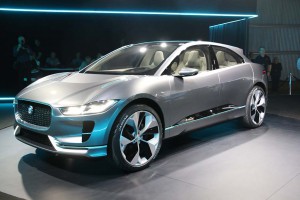
Ralf Speth, Jaguar Land Rover CEO, estimates that as much as 50% of Jaguar Land Rover's sales will be battery electric vehicles.
It took only a matter of minutes for the first buyer to reserve one of the new Jaguar I-Pace battery-electric vehicles, clicking on the “I Want” button added to the British maker’s website following the debut of a concept version at the Los Angeles Auto Show this week.
That was reassuring news for Jaguar’s top management team which authorized the costly development project that will see the production version of the I-Pace roll into showrooms in 2018. And the electric SUV is likely to be only the first in a wave of new battery-based models for both Jaguar and its sibling Land Rover brand, according to CEO Ralf Speth.
As much as “40 to 50%” of the Jaguar Land Rover line-up could use hybrid, plug-in or full battery-electric propulsion by 2020, Speth hinted during a conversation with a handful of journalists at the L.A. Auto Show. And while he declined to discuss specific plans, he acknowledged that the company did not develop the unique platform underpinning the I-Pace just for one product.
Going electric is “a huge challenge for a small company like ours,” said Speth, adding that for once, Jaguar decided it needed to “lead, not follow” in an area of cutting-edge technology.
The I-Pace follows the recent launch of the Jaguar F-Pace, the brand’s first sport-utility vehicle. But the two models have relatively little in common. Rather than just try to stuff batteries into an existing platform, JLR engineers developed an entirely new architecture. Much like the approach used by Tesla Motors, the battery pack rides under the load floor, with an electronic drive unit on each axle. The approach allows for a cab-forward design with a “class-above” level of interior space.

The Jaguar I-Pace concept borrows from Tesla's design that pushes the battery packs into the floor to save space and improve handling.
(Jaguar returns to racing with I-Type Electric. Click Here for more.)
Equally significant, though it sources the battery cells from an undisclosed supplier, Jaguar also chose to develop virtually all of the remaining electric drive technology, including the EDUs, which each combine a synchronous motor and single-speed transmission.
Some skeptics might question that approach considering the limited resources available to a company like JLR – even with a deep-pocket parent like Indian industrial conglomerate Tata. After all, sales of battery-based vehicles have been marginal, at best. In the U.S., in particular, hybrids, plug-ins and EVs combined have accounted for barely 3% of the overall market this year.
But IHS Automotive forecasts a huge surge in the relatively near future, predicting pure battery-electric models alone will generate 3 million sales worldwide by 2023. And BorgWarner, a major supplier of “propulsion” technology, last week estimated the actual number could reach double that level.
The age of the electric vehicle “is going to come,” declared JLR CEO Speth, suggesting that in not all that many years, children “may not know the wonderful exhaust sound of the F-Type.”
(Click Here for more about Jaguar’s commitment to using diesel engines.)
It will take several steps to get there, the Bavarian-born executive cautioned. For one thing, battery cells will need to “come down to the level of $100 per kilowatt-hour.” But the trend is moving in the right direction. General Motors, which initially was paying about $1,000 a kWh for the batteries in its Chevy Volt plug-in hybrid in 2009 is now paying around $150 for the battery cells in the Chevy Bolt EV.
The other challenge, said Speth, will be developing a charging infrastructure. But that appears to be moving fast. Just this week, a consortium of energy and service providers announced plans to add thousands more chargers in California. Meanwhile, there’s growing momentum for super-fast Level 3 systems that could cut charging times from hours to 30 minutes or less. And Level 4 systems, which could replenish up to 80% of an I-Pace’s 220-mile range in 10 minutes, are in development.
While Jaguar is taking a lead in electrification, the British firm is holding back on autonomous driving systems. Speth is a short-term skeptic, cautioning that the technology still has a lot of development work ahead. Longer-term, Jaguar appears to be betting that suppliers such as Continental, or even Google, will ultimately offer turn-key solutions that won’t require Jaguar to divert a chunk of its limited product-development budget today.
The company has been investing heavily to expand what was long a very limited product line-up. It’s paying off. Land Rover is experiencing record global sales and after a number of years of decline, Jaguar is on the rebound. For the first 10 months of the year, worldwide sales were up 74%, with the new F-Pace utility vehicle playing the single-biggest role in that surge.
At least one more conventionally powered SUV is believed to be in the pipeline, and though he wouldn’t discuss specifics, Joe Eberhardt, CEO of JLR’s North American operations, made it clear the company has other plans for tapping “the fastest-growing” segment of the market. “Every manufacturer, including ourselves, has to think about what other opportunities are out there.”
(To see our first driving impressions of the 2017 Jaguar XE, Click Here.)
A key question JLR is considering is which niche to target next. Smaller luxury SUVs, such as the BMW 1-series, are gaining momentum fast. But there’s plenty of demand for even larger utes, as well, said Eberhardt, and profit margins are larger. What seems clear is that JLR will be expanding its line-up soon, whether with battery-powered models or those using more conventional gas and electric drivetrains.
